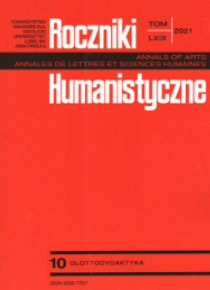NAUCZANIE GRAMATYKI I LEKSYKI POPRZEZ SZTUKĘ. EKFRAZA, INFRAZA I AUDIODESKRYPCJA NA LEKCJI JĘZYKA OBCEGO
TEACHING GRAMMAR AND LEXIS THROUGH ART: EKPHRASIS, INPHRASIS AND AUDIO DESCRIPTION DURING A FOREIGN LANGUAGE LESSON
Author(s): Agnieszka Palion-MusiołSubject(s): Foreign languages learning, Visual Arts, Language acquisition, Pedagogy
Published by: Towarzystwo Naukowe KUL & Katolicki Uniwersytet Lubelski Jana Pawła II
Keywords: literature; art; intersemiotic translation in a foreign language class; ekphrasis, inphrasis; audio description;
Summary/Abstract: The correspondence between art and the intersemiotic dialogue in which literary texts and paintings are involved creates new possibilities for the teaching of foreign languages. Both ekphrasis and its contrastive inphrasis tend to subjectively represent paintings and literary texts, while trying to replace them and reveal their presence as a new symbol. Audio description plays a similar function – through an objective description of visual texts, it aims to make them livelier, more present, and more accessible to a blind person. Ekphrasis, inphrasis and audio description exist as a result of the creative transposition and interpretation which accompany the intersemiotic translation. This process is conducted by the student. Each of the representations mentioned, and every contact with art, offers many benefits during foreign language classes. Apart from linguistic benefits, such as gaining an additional opportunity to practice grammatical structures, introducing new vocabulary, and developing communication and intercultural skills, it is also important to note the neurodidactic aspect of art while conducting a foreign language lesson.
Journal: Roczniki Humanistyczne
- Issue Year: 69/2021
- Issue No: 10
- Page Range: 91-107
- Page Count: 17
- Language: Polish

